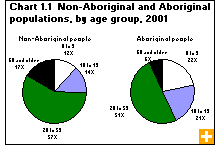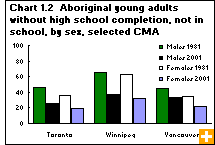Common menu bar links
Aboriginal peoples
Archived Content
Information identified as archived is provided for reference, research or recordkeeping purposes. It is not subject to the Government of Canada Web Standards and has not been altered or updated since it was archived. Please contact us to request a format other than those available.
In 2001, just over 1.3 million Canadians reported that their ancestors belonged to at least one of the Aboriginal peoples defined by The Constitution Act (1982)—North American Indian, Inuit and Métis, each of which have unique heritages, languages, cultural practices and spiritual beliefs.
However, not everyone with Aboriginal ancestry reported that they were Aboriginal people. In the 2001 Census, 976,305 people identified themselves as members of at least one of these Aboriginal groups.
In 2001, North American Indians, also called First Nations peoples, made up 62% of the Aboriginal population, while 30% identified as Métis and 5% as Inuit. The remaining 3% could not be classified into just one Aboriginal group, or they were registered Indians or band members who did not identify as Aboriginal peoples. Eighty percent of First Nations people also reported they were registered under the Indian Act.
Distribution of Aboriginal people
Aboriginal people accounted for a large share of the population in the territories in 2001: 85% in Nunavut, 51% in the Northwest Territories and 23% in Yukon. However, the largest absolute numbers lived in Ontario (188,000), followed by British Columbia (170,000), Alberta (156,000), Manitoba (150,000) and Saskatchewan (130,000).
Among metropolitan areas, Winnipeg is home to the largest Aboriginal population. Almost 56,000 were counted in 2001, or more than 8% of the city’s residents. Winnipeg is also home to the largest Métis population (just over 31,000) and registered Indian population (19,000). Vancouver has the largest non-registered Indian population (8,000).
The Aboriginal identity population grew by 22% from 1996 to 2001, while the non-Aboriginal population grew 3%. About half of this Aboriginal population increase was the result of demographic or natural growth—higher fertility rates, for example. The other half was the result of non-demographic factors, such as better census coverage compared with previous years and a rising tendency for Aboriginal peoples to self-identify. Natural growth alone could increase the Aboriginal identity population to 1.4 million by 2017.
A young and growing population
From 1996 to 2001, the Métis population grew by 43%, First Nations people by 15% and the Inuit by 12%. Natural increase accounted for most of the growth among the First Nations and Inuit populations, whereas non-demographic factors explained most of the Métis population growth.
In 2001, half of all Aboriginal people were under 25. In sharp contrast, half of non-Aboriginal people were under 38. The Inuit have the youngest population in Canada (half are under 21), followed by First Nations (half are under 24) and Métis (half are under 27).
The number of Aboriginal people in their twenties is projected to increase dramatically. This may change the profile of job seekers in some parts of the country. Projections indicate that by 2017, Aboriginal people aged 20 to 29 will make up 30% of those in their 20s in Saskatchewan, 24% in Manitoba, 40% in Yukon and 58% in the Northwest Territories. Already, 80% of Nunavut’s population of 20- to 29-year-olds are Aboriginal people, and the proportion is expected to grow.
Quality of life gaps
Aboriginal people in Canada do not share the same quality of life as the general population. Their situation differs greatly by where they live, by Aboriginal group and by gender. For example, 1 in 3 Inuit living in the Arctic in 2001 reported there were times of the year when their water was contaminated.
In 2001, 14% of Aboriginal people were living in overcrowded housing conditions, compared with 4% of the general population. The highest percentage for overcrowded housing was found among Inuit, a rate of 32%. The overcrowding rate for First Nations people on reserves was also high at 25%.
Although the employment rate from 1996 to 2001 increased at a faster pace for Aboriginal people than for non-Aboriginal people, a gap remains. In 2001, 62% of non-Aboriginal people were employed, compared with 59% of Métis, 49% of Inuit and 45% of First Nations peoples.
Among the off-reserve population in Western Canada in 2005, the employment rate for Métis was similar to the non-Aboriginal population, 65%. The employment rate was far lower for First Nations peoples, 51%.
The share of Aboriginal people aged 20 to 24 who had not completed high school dropped substantially from 1981 to 2001, tumbling from 64% to 47% for men and from 61% to 40% for women. Aboriginal women are now more likely than Aboriginal men to have a college diploma or a university degree.
Nonetheless, from 1981 to 2001, the proportion of non-Aboriginal people with a university degree grew faster than the same proportion for Aboriginal people. This is important because education appears to reduce the employment gap between Aboriginal and non-Aboriginal Canadians. In 2001, for instance, the employment rates of Aboriginal and non-Aboriginal university graduates aged 20 to 64 were virtually identical.





